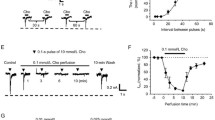Abstract
The effect of cyanide on NMDA-activated ion current and MK801 binding was studied in cultured rat hippocampal neurons. In microfluorometric analysis using fura-2, removal of extracellular Mg2+ resulted in a five-fold increase in NMDA-induced peak of [Ca2+]i. One mM NaCN enhanced the peak NMDA responses in the presence, but not in the absence of extracellular Mg2+. Cyanide enhanced the immediate rise in [Ca2+]i produced by NMDA, followed over a 1–5 min period by a gradual increase of [Ca2+]i. Similar results were obtained in whole-cell patch clamp recordings from hippocampal neurons. One mM KCN enhanced the NMDA-activated current in the presence, but not in the absence of extracellular Mg2+. This effect was independent of cyanide-mediated metabolic inhibition since the recording pipette contained ATP (2 mM). In binding assays NaCN (1 mM) increased the binding affinity of [3H]MK-801 to rat forebrain membranes in the presence of Mg2+, whereas in the absence of Mg2+, NaCN did not influence binding. These results indicate that cyanide enhances NMDA-mediated Ca2+ influx and inward current by interacting with the Mg2+ block of the NMDA receptor. The effect of cyanide can be explained by an initial interaction with the Mg2+ block of the NMDA receptor/ionophore which appears to be energy-independent, followed by a gradual increase in Ca2+ influx resulting from cellular energy reserve depletion.
Similar content being viewed by others
Abbreviations
- NMDA:
-
N-Methyl-D-Aspartate
- EAA:
-
excitatory amino acid
- MK-801:
-
(+)-5-methyl-10,11-dihydro-5H-dibenzo[a,d] cyclohept-5,10-imine maleate
References
Benveniste, H., Drejer, J., Schousboe, A., and Diemer, N. H. 1984. Elevation of the extracellular concentrations of glutamate and aspartate in the rat hippocampus during transient cerebral ischemia monitored by intracerebral microdialysis. J. Neurochem. 43:1369–1374.
Cai, Z., and McCaslin, F. P. 1992. Selective effects of cyanide (100 μM) on the excitatory amino acid-induced elevation of intracellular calcium levels in neuronal culture. Neurochem. Res. 17:803–808.
Choi, D. W. 1985. Glutamate neurotoxicity in cortical cell culture is calcium dependent. Neurosci. Lett. 58:293–297.
Choi, D. W., and Rothman, S. M. 1990. The role of glutamate neurotoxicity in hypoxic-ischemic neuronal death. Annu. Rev. Neurosci. 13:171–182.
Forsythe, I. D., and Westbrook, G. L. 1988. Slow excitatory postsynaptic currents mediated by N-methyl-D-aspartate receptors on cultured mouse central neurones. J. Physiol. 396:515–533.
Carthwaite, G., and Garthwaite, J. 1986. Neurotoxicity of excitatory amino acid receptor agonists in rat cerebellar slices: Dependence on calcium concentration. Neurosci. Lett. 66:193–198.
Henneberry, R. C. 1989. The role of neuronal energy in the neurotoxicity of excitatory amino acids. Neurobiol. Aging 10:611–613.
Isom, G. E., and Way, J. L. 1976. Lethality of cyanide in the absence of inhibition of liver cytochrome oxidase. Biochem. Pharmacol. 25:605–608.
Keilin, D. 1930. Cytochrome and intracellular oxidase. Proc. R. Soc. London, B. 106:418–444.
Maduh, E. U., Borowitz, J. L., and Isom, G. E. 1991. Cyanide-induced alteration of the adenylate energy pool in a rat neurose-cretory cell line. J. Appl. Toxicol. 11:97–101.
Marty, A., and Neher, E. 1983. Tight-seal whole-cell recording. pages 107–122,in B. Sakmann and E. Neher (ed.), Single-channel Recording, Plenum Press, New York.
McPherson, G. A. 1983. A practical computer-based approach to the analysis of radioligand binding experiments. Comput. Programs Biomed. 17:107–117.
Novelli, A., Reilly, J. A., Lysko, P. G., and Henneberry, R. C. 1988. Glutamate becomes neurotoxic via the N-methyl-D-aspartate receptor when intracellular energy levels are reduced. Brain Res. 451:205–212.
Patel, M. N., Ardelt, B. K., Yim, G. K. W., and Isom, G. E. 1991. Cyanide induces Ca2+-dependent and independent release of glutamate from mouse brain slices. Neurosci. Lett. 131:42–44.
Patel, M. N., Yim, G. K. W., and Isom, G. E. 1992. Blockade of N-methyl-D-aspartate receptors prevents cyanide-induced neuronal injury in primary hippocampal culture. Toxicol. Appl. Pharmacol. 115:124–129.
Patel, M. N., Yim, G. K. W., and Isom, G. E. 1993. N-methyl-D-aspartate receptors mediate cyanide-induced cytotoxicity in hippocampal cultures. Neurotoxicol. 14:35–40.
Ransom, R. W., and Stec, N. L. 1988. Cooperative modulation of [3H]MK-801 binding to the N-methyl-D-aspartate receptor-ion channel complex by L-glutamate, glycine and polyamines. J. Neurochem. 51:830–836.
Reynolds, I. J., Murphy, S. N., and Miller, R. J. 1987.3H-labeled MK-801 binding to the excitatory amino acid receptor complex from rat brain is enhanced by glycine. Proc. Natl. Acad. Sci. (U.S.A.) 84:7744–7748.
Reynolds, I. J., and Miller, R. J. 1988. [3H]MK-801 binding to the NMDA receptor/ionophore complex is regulated by divalent cations: evidence for multiple regulatory sites. Eur. J. Pharmacol. 151:103–112.
Reynolds, I. J., and Miller, R. J. 1988. Tricyclic antidepressants block N-methyl-D-aspartate receptors: similarities to the actions of zinc. Br. J. Pharmacol. 95:95–102.
Wong, E. H. F., Knight, A. R., and Woodruff, G. N. 1988. [3H]MK-801 labels a site on the N-methyl-D-aspartate receptor channel complex in rat brain membrane. J. Neurochem. 50:274–281.
Zeevalk, G. D., and Nichlas, W. J. 1992. Evidence that the loss of the voltage-dependent Mg2+ block at the N-methyl-D-aspartate receptor underlies receptor activation during inhibition of neuronal metabolism. J. Neurochem. 59:1211–1220.
Author information
Authors and Affiliations
Rights and permissions
About this article
Cite this article
Patel, M.N., Peoples, R.W., Yim, G.K.W. et al. Enhancement of NMDA-mediated responses by cyanide. Neurochem Res 19, 1319–1323 (1994). https://doi.org/10.1007/BF01006824
Accepted:
Issue Date:
DOI: https://doi.org/10.1007/BF01006824



